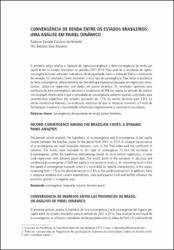Please use this identifier to cite or link to this item:
https://repositorio.ipea.gov.br/handle/11058/9749Full metadata record
| DC Field | Value | Language |
|---|---|---|
| dc.contributor.author | Almeida, Rubiane Daniele Cardoso de | - |
| dc.contributor.author | Moreira, Tito Belchior Silva | - |
| dc.coverage.spatial | Brasil | pt_BR |
| dc.coverage.temporal | 2001-2014 | pt_BR |
| dc.date.accessioned | 2020-03-25T14:49:25Z | - |
| dc.date.available | 2020-03-25T14:49:25Z | - |
| dc.date.issued | 2019-06 | - |
| dc.identifier.uri | http://repositorio.ipea.gov.br/handle/11058/9749 | - |
| dc.description.abstract | O presente artigo analisa a hipótese de sigma-convergência e beta-convergência de renda per capita entre os estados brasileiros no período 2001-2014. Para analisar a existência de sigma-convergência, foram utilizados indicadores de desigualdade, como o de Theil e o coeficiente de variação. Os resultados foram favoráveis a esse tipo de convergência. Para testar a existência de beta-convergência, diferentemente da metodologia tradicional baseada em regressões cross-section, utilizou-se regressões com dados em painel dinâmico. Os resultados apontam para existência de beta-convergência absoluta e condicional do PIB per capita no período de análise. Um resultado interessante é que a velocidade de convergência aumenta quando controlado para características específicas dos estados, passando de 1,7% na versão absoluta para 2,8% na versão condicional. Ademais, há evidencias empíricas de que as despesas correntes, o Fundo de Participação Estadual e a fecundidade influenciam negativamente o crescimento econômico. | pt_BR |
| dc.language.iso | pt-BR | pt_BR |
| dc.publisher | Instituto de Pesquisa Econômica Aplicada (Ipea) | pt_BR |
| dc.title | Convergência de renda entre os estados brasileiros : uma análise em painel dinâmico | pt_BR |
| dc.type | Planejamento e Políticas Públicas (PPP) - Artigos | pt_BR |
| dc.rights.holder | Instituto de Pesquisa Econômica Aplicada (Ipea) | pt_BR |
| dc.source.urlsource | http://www.ipea.gov.br/ppp | pt_BR |
| dc.location.country | BR | pt_BR |
| dc.description.physical | p. 325-354 : il. | pt_BR |
| dc.subject.vcipea | IPEA::Cultura. Sociedade::Sociedade::Classe Social::Desigualdade Social | pt_BR |
| dc.subject.vcipea | IPEA::Condições Econômicas. Pesquisa Econômica. Sistemas Econômicos::Condições Econômicas::Crescimento Econômico::Desigualdade Econômica | pt_BR |
| dc.subject.vcipea | IPEA::Condições Econômicas. Pesquisa Econômica. Sistemas Econômicos::Condições Econômicas::Crescimento Econômico::Desigualdade Regional | pt_BR |
| dc.rights.license | É permitida a reprodução deste texto e dos dados nele contidos, desde que citada a fonte. Reproduções para fins comerciais são proibidas. | pt_BR |
| dc.subject.keyword | Convergência | pt_BR |
| dc.subject.keyword | Desigualdade de renda | pt_BR |
| dc.subject.keyword | Painel dinâmico | pt_BR |
| dc.relation.references | http://repositorio.ipea.gov.br/handle/11058/9713 | pt_BR |
| ipea.description.additionalinformation | Artigo publicado em: Planejamento e Políticas Públicas (): n. 52, jan./ jun. 2019. | pt_BR |
| ipea.description.additionalinformation | Resumos em português, inglês, espanhol e francês. | pt_BR |
| ipea.description.additionalinformation | Possui referências bibliográficas. | pt_BR |
| ipea.access.type | Acesso Aberto | pt_BR |
| ipea.rights.type | Licença Comum | pt_BR |
| ipea.englishdescription.abstract | The present article analyzes the hypothesis of σ-convergence and β-convergence of per capita income between the brazilian states for the period from 2001 to 2014. To analyze the existence of σ-convergence we used inequality indicators such as the Theil index and the coefficient of variation. The results were favorable to this type of convergence. To test the existence of β-convergence, unlike the traditional methodology based on cross-section regressions, it were used regressions with dynamic panel data. The results point to the existence of absolute and conditional β-convergence of per capita in the period of analysis. An interesting result is that the speed of convergence increases when it is controlled for specific characteristics of the states, increasing from 1.7% in the absolute version to 2.8% in the conditional version. In addition, there is empirical evidence that current expenditures, state participation fund and fertility influence the economic growth is a negative way. | pt_BR |
| ipea.researchfields | N/A | pt_BR |
| ipea.classification | Desenvolvimento Regional | pt_BR |
| ipea.classification | Desenvolvimento Social | pt_BR |
| Appears in Collections: | Desenvolvimento Social: Artigos | |
Files in This Item:
| File | Description | Size | Format | |
|---|---|---|---|---|
| ppp_n52_convergencia.pdf | 300.83 kB | Adobe PDF |  View/Open |
Items in DSpace are protected by copyright, with all rights reserved, unless otherwise indicated.

